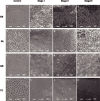Effect of erosive and abrasive stress on sealing ability of different desensitizers: In-vitro study
- PMID: 31369650
- PMCID: PMC6675100
- DOI: 10.1371/journal.pone.0220823
Effect of erosive and abrasive stress on sealing ability of different desensitizers: In-vitro study
Abstract
This in vitro study examined the sealing ability of different desensitizing agents under a chemo-mechanical stress condition. For the study, a total of 144 extracted, caries-free human third molars were used to produce 1 mm-thick dentin discs. The specimens were divided randomly into four groups: Superseal (SS), Gluma (GL), Gluma Self-etch (GS), and Tooth Coat (TC). For each group, the permeability was measured before and after applying the desensitizer, after being exposed to Coca Cola for 5 minutes, and after 3150 strokes of a brushing abrasion. The decrease in permeability after the erosive and abrasive stress was analyzed by ANOVA and Tukey post hoc test. As a result, the dentin permeability decreased significantly for all desensitizers immediately after application (p < 0.05). SS and GS showed a significant difference in permeability reduction observed immediately after application and after acid action with Coca Cola (p < 0.05). After brushing abrasion, the permeability reduction decreased significantly for all desensitizers tested in this study (p < 0.05). TC showed the largest decrease in dentinal permeability compared to that of the other desensitizers and the differences were significant after brushing abrasion (p < 0.05). All tested desensitizers were effective in reducing dentin permeability. The behavioral characteristics under erosive and abrasive stress varied according to the products used. TC exhibited excellent sealing ability among the other desensitizers.
Conflict of interest statement
The authors have declared that no competing interests exist.
Figures




Similar articles
-
Effect of Erosion/Abrasion Challenge on the Dentin Tubule Occlusion Using Different Desensitizing Agents.Braz Dent J. 2017 Mar-Apr;28(2):216-224. doi: 10.1590/0103-6440201700811. Braz Dent J. 2017. PMID: 28492753
-
Effectiveness and acid/tooth brushing resistance of in-office desensitizing treatments-A hydraulic conductance study.Arch Oral Biol. 2018 Dec;96:130-136. doi: 10.1016/j.archoralbio.2018.09.004. Epub 2018 Sep 12. Arch Oral Biol. 2018. PMID: 30237094
-
Effect of dentin desensitizers and dentin bonding agents on dentin permeability.Am J Dent. 2000 Feb;13(1):21-7. Am J Dent. 2000. PMID: 11763898
-
Evaluation of the permeability of five desensitizing agents using computerized fluid filtration.Niger J Clin Pract. 2015 Sep-Oct;18(5):601-6. doi: 10.4103/1119-3077.158949. Niger J Clin Pract. 2015. PMID: 26096236
-
Clinical uses of glutaraldehyde/2-hydroxyethylmethacrylate (GLUMA).Northwest Dent. 2013 Mar-Apr;92(2):27-30. Northwest Dent. 2013. PMID: 23757813 Review.
Cited by
-
Assessment of Demineralization Inhibition Effects of Dentin Desensitizers Using Swept-Source Optical Coherence Tomography.Materials (Basel). 2021 Apr 9;14(8):1876. doi: 10.3390/ma14081876. Materials (Basel). 2021. PMID: 33918865 Free PMC article.
References
-
- Absi EG, Addy M., Adams D. Dentine hypersensitivity. A study of the patency of dentinal tubules in sensitive and non-sensitive cervical dentine. J Clin Periodontol. 1987;14:280–284. - PubMed
-
- Jacobsen PL, Bruce G. Clinical dental hypersensitivity: Understanding the causes and prescribing a treatment. J Contemp Dent Pract. 2001;2: 1–12. - PubMed
MeSH terms
Substances
LinkOut - more resources
Full Text Sources
Research Materials

